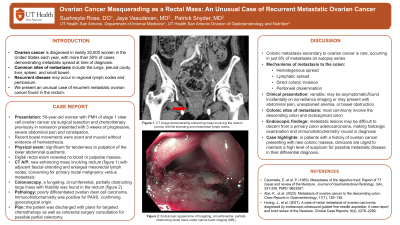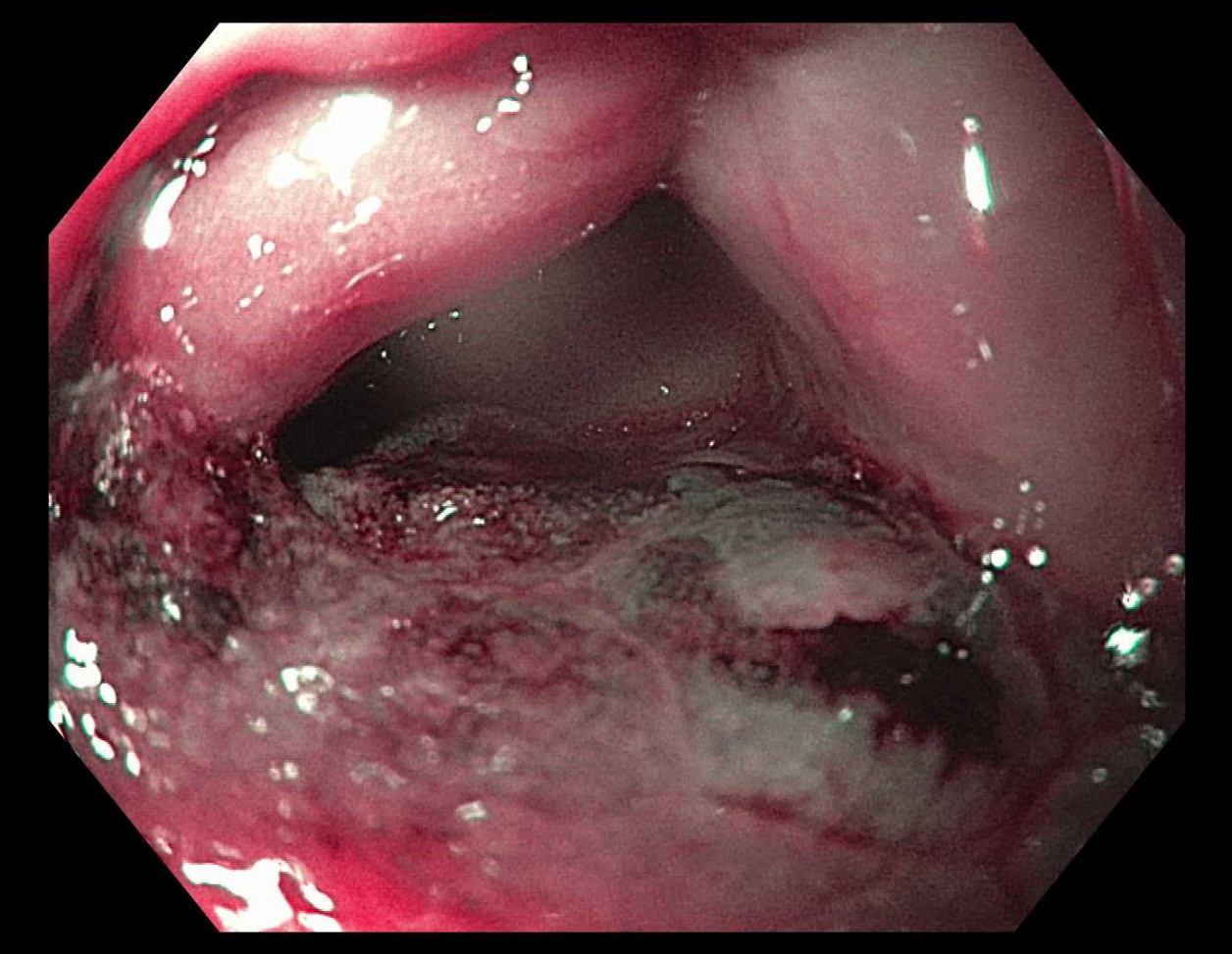Monday Poster Session
Category: General Endoscopy
P2416 - Ovarian Cancer Masquerading as a Rectal Mass: An Unusual Case of Recurrent Metastatic Ovarian Cancer
Monday, October 28, 2024
10:30 AM - 4:00 PM ET
Location: Exhibit Hall E

Has Audio

Sushreyta Rose, DO
UTHSCSA
San Antonio, TX
Presenting Author(s)
Sushreyta Rose, DO1, Jaya Vasudevan, MD2, Patrick Snyder, MD3
1UTHSCSA, San Antonio, TX; 2University of Texas Health Science Center, San Antonio, TX; 3University of Texas Health San Antonio, San Antonio, TX
Introduction: Ovarian cancer is diagnosed in almost 20,000 women in the United States each year, with metastatic spread seen in greater than 50% of cases at the time of diagnosis. Common sites of metastasis include the lung, pleural cavity, liver, spleen and the small bowel, with recurrent disease normally seen in the peritoneum or regional lymph nodes. Here we present an unusual case of recurrent metastatic ovarian cancer in the rectum.
Case Description/Methods: A 50-year-old woman with a history of stage 1 clear cell ovarian cancer managed with surgical resection and chemotherapy previously in remission presented with severe abdominal pain and constipation for three weeks. She reported that her recent bowel movements were scant and mucoid without evidence of hematochezia. Physical exam was significant for tenderness to palpation of the lower abdominal quadrants, and digital rectal exam revealed no blood or palpable masses. CT revealed a new enhancing mass involving rectum with adjacent fascial stranding and enlarged mesorectal lymph nodes concerning for primary rectal malignancy versus metastasis. Colonoscopy revealed a fungating, circumferential, partially obstructing large mass in the rectum (figure 1). Extensive biopsies of the mass revealed poorly differentiated ovarian clear cell carcinoma. Immunohistochemical staining was positive for PAX8 confirming gynecological origin. She was discharged with plans for targeted chemotherapy and colorectal surgery consultation for possible partial colectomy.
Discussion: Colonic metastasis from ovarian cancer is rare, comprising just 6% of metastases on autopsy series. Mechanisms of spread to the colon include hematogenous, lymphatic, direct colonic invasion and peritoneal dissemination. GI tract metastasis from ovarian cancer may occur years after the initial cancer diagnosis; patients can be asymptomatic or may present with symptoms similar to a primary colonic malignancy such as abdominal pain, unexplained anemia, or bowel obstruction. The descending and rectosigmoid colon are the most common sites of ovarian carcinoma metastasis. On endoscopic appearance, metastatic lesions may be difficult to discern from a primary colon adenocarcinoma, making histologic examination and immunohistochemistry crucial in diagnosis. In patients with a history of ovarian cancer presenting with new colonic masses, clinicians are thus urged to maintain a high level of suspicion for possible metastatic disease in their differential diagnosis.

Disclosures:
Sushreyta Rose, DO1, Jaya Vasudevan, MD2, Patrick Snyder, MD3. P2416 - Ovarian Cancer Masquerading as a Rectal Mass: An Unusual Case of Recurrent Metastatic Ovarian Cancer, ACG 2024 Annual Scientific Meeting Abstracts. Philadelphia, PA: American College of Gastroenterology.
1UTHSCSA, San Antonio, TX; 2University of Texas Health Science Center, San Antonio, TX; 3University of Texas Health San Antonio, San Antonio, TX
Introduction: Ovarian cancer is diagnosed in almost 20,000 women in the United States each year, with metastatic spread seen in greater than 50% of cases at the time of diagnosis. Common sites of metastasis include the lung, pleural cavity, liver, spleen and the small bowel, with recurrent disease normally seen in the peritoneum or regional lymph nodes. Here we present an unusual case of recurrent metastatic ovarian cancer in the rectum.
Case Description/Methods: A 50-year-old woman with a history of stage 1 clear cell ovarian cancer managed with surgical resection and chemotherapy previously in remission presented with severe abdominal pain and constipation for three weeks. She reported that her recent bowel movements were scant and mucoid without evidence of hematochezia. Physical exam was significant for tenderness to palpation of the lower abdominal quadrants, and digital rectal exam revealed no blood or palpable masses. CT revealed a new enhancing mass involving rectum with adjacent fascial stranding and enlarged mesorectal lymph nodes concerning for primary rectal malignancy versus metastasis. Colonoscopy revealed a fungating, circumferential, partially obstructing large mass in the rectum (figure 1). Extensive biopsies of the mass revealed poorly differentiated ovarian clear cell carcinoma. Immunohistochemical staining was positive for PAX8 confirming gynecological origin. She was discharged with plans for targeted chemotherapy and colorectal surgery consultation for possible partial colectomy.
Discussion: Colonic metastasis from ovarian cancer is rare, comprising just 6% of metastases on autopsy series. Mechanisms of spread to the colon include hematogenous, lymphatic, direct colonic invasion and peritoneal dissemination. GI tract metastasis from ovarian cancer may occur years after the initial cancer diagnosis; patients can be asymptomatic or may present with symptoms similar to a primary colonic malignancy such as abdominal pain, unexplained anemia, or bowel obstruction. The descending and rectosigmoid colon are the most common sites of ovarian carcinoma metastasis. On endoscopic appearance, metastatic lesions may be difficult to discern from a primary colon adenocarcinoma, making histologic examination and immunohistochemistry crucial in diagnosis. In patients with a history of ovarian cancer presenting with new colonic masses, clinicians are thus urged to maintain a high level of suspicion for possible metastatic disease in their differential diagnosis.

Figure: Image 1: Endoscopic appearance of fungating, circumferential, partially obstructing rectal mass under narrow band imaging (NBI).
Disclosures:
Sushreyta Rose indicated no relevant financial relationships.
Jaya Vasudevan indicated no relevant financial relationships.
Patrick Snyder indicated no relevant financial relationships.
Sushreyta Rose, DO1, Jaya Vasudevan, MD2, Patrick Snyder, MD3. P2416 - Ovarian Cancer Masquerading as a Rectal Mass: An Unusual Case of Recurrent Metastatic Ovarian Cancer, ACG 2024 Annual Scientific Meeting Abstracts. Philadelphia, PA: American College of Gastroenterology.
